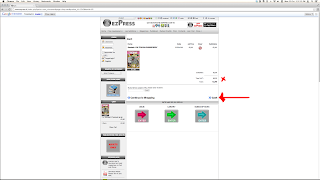I used to subscribe to one of the Italian needlework magazines called
Ricamo Italiano which started up in the fall of 2004. The subscription for overseas was about double the European price but at the time I could afford it and anyway, I usually figure on paying about double the cover price for any publication from Italy because the shipping is so much.
In 2010 they decided to raise the overseas price for a subscription so much that I had to give them up.
Silvia from Turin emailed me to say that she had discovered that they now have a digital edition which you can purchase and download instantly.
I decided to purchase an issue and take you along with me for the ride. Before we get started, let me say that I'm not recommending/soliciting this magazine and I don't earn anything by this post. This is just an adventure in Italian Needlework.
I took screenshots along the way and then added some arrows in with Photoshop. My monitor is a 27 inch iMac so I'm sorry, there is a lot of white space but I didn't want to cut anything off that might help you if you were going to try this.
Now, I didn't find anything indicating that this was even available on the
Ricamo Italiano website, but there might be something there that I just didn't see, or they may have updated it since this post if you're reading this sometime in the future.
Click on the photos for a closer look.
Arriving at the
EZPRess website, which thanks to
Silvia, we know exists, use the pull down menu at the top for English or which ever language you like, it uses
Google Translate which does an okay job for what we need here.
On the left is a "search by category" heading with directly below it another pull down menu. For reasons probably to do with translation, the list does not appear in English alphabetical order, so you'll find "embroidery" under "boys". Don't ask, just select "embroidery" and let's move on. ;-)
There are only two choices for "embroidery" and they are both
Ricamo Italiano, so you can take your pick between September 2012 (issue 95) or October 2012 (issue 96) or you can sign up for a subscription. I chose issue 96 and clicked on "acquista ora" - the buttons don't translate.
When you click the button a little pop up menu tells you that what you've selected has been added to your cart and you have the option to continue shopping or going on to the cart and paying which is the option I chose.
Now you must click on "cash", you'll notice my "x" shows that you must pay the value added tax or VAT. Many international websites are set up so that the program knows if you're overseas and that you are not required to pay the VAT. This is not one of them. I also understand that in Italy there is a difference in business license, if you anticipate mainly Italian clients, you choose one license, if you anticipate international clients, you choose the other (more expensive) license. These people are anticipating Italian clients and I'm not going to argue over €0,50 which is like, $0.65USD.
Now we must register with EZPress. Click accordingly and you will land at the page which gives you some advice about google.mail clients. I forgot to take a screenshot of this page until after I'd finished, so you may notice in the next photo that my cart is empty on the left. Yours however should still have your magazine in it.
Click "register" and we go on to the cart where you have your choice of payment methods. I chose PayPal and then "check out" at the bottom.
Now, I wasn't quick enough to get the next screenshot but a big green check mark flashed on the screen and some text telling me that I'd entered my order correctly and that I was now being re-routed to PayPal's website, which I was.
After completing my PayPal payment, I chose to return to the EZPress website and landed at this page. I clicked where I indicate with the red arrow, but if you chose a subscription you must click where I've put the 'x".
This brings you to your order summary and you must remember to download both the magazine and the "foglione" which has some patterns on it. It looks like you can do this 100 times each.
What they don't tell you is that the magazine file is 74.1MB so that takes a few minutes to load. The 'foglione' is only 135 KB (for issue 96). The magazine is 86 pages.
If you choose the subscription, you get the same price that Italians get for a printed subscription and you'll get "12 months". Just a word to the wise, this magazine does not always print issues in consecutive months so "12 months" usually takes you into the following year. This can be confusing but at least this way, you'll know it didn't get lost in the mail!


























